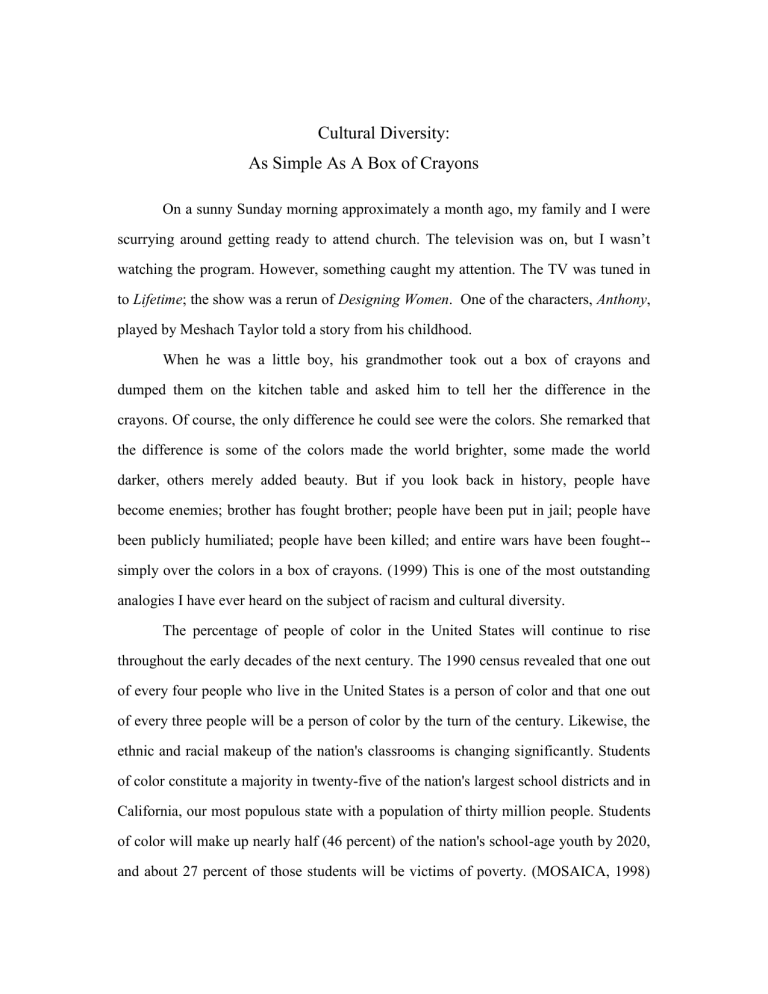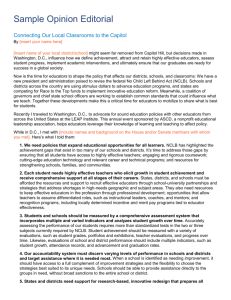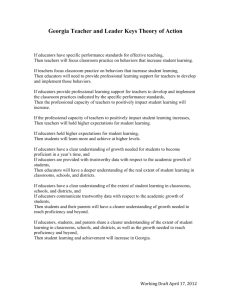Cultural Diversity: As Simple as a Box of Crayons

Cultural Diversity:
As Simple As A Box of Crayons
On a sunny Sunday morning approximately a month ago, my family and I were scurrying around getting ready to attend church. The television was on, but I wasn’t watching the program. However, something caught my attention. The TV was tuned in to Lifetime ; the show was a rerun of Designing Women . One of the characters, Anthony , played by Meshach Taylor told a story from his childhood.
When he was a little boy, his grandmother took out a box of crayons and dumped them on the kitchen table and asked him to tell her the difference in the crayons. Of course, the only difference he could see were the colors. She remarked that the difference is some of the colors made the world brighter, some made the world darker, others merely added beauty. But if you look back in history, people have become enemies; brother has fought brother; people have been put in jail; people have been publicly humiliated; people have been killed; and entire wars have been fought-- simply over the colors in a box of crayons. (1999) This is one of the most outstanding analogies I have ever heard on the subject of racism and cultural diversity.
The percentage of people of color in the United States will continue to rise throughout the early decades of the next century. The 1990 census revealed that one out of every four people who live in the United States is a person of color and that one out of every three people will be a person of color by the turn of the century. Likewise, the ethnic and racial makeup of the nation's classrooms is changing significantly. Students of color constitute a majority in twenty-five of the nation's largest school districts and in
California, our most populous state with a population of thirty million people. Students of color will make up nearly half (46 percent) of the nation's school-age youth by 2020, and about 27 percent of those students will be victims of poverty. (MOSAICA, 1998)
One important implication of these demographic trends is that education in the twenty-first century must help low-income students and students of color to develop the knowledge, attitudes, and skills necessary to participate in the work force and in society.
This goal is not possible without restructuring schools and establishing new goals and ideals within them. As currently organized, most schools today are unable to help most low-income students and students of color attain these goals.
According to a handout entitled Summary of the World by Dr. Jacqueline
Schliefer in BE 486, if we could shrink the Earth’s population to a village of 100 people, with all existing human ratios remaining the same, it would look like this:
There would be 57 Asians, 21 Europeans, 14 from the Western Hemisphere, including North and South America, and eight from Africa.
Fifty-one would be female and 49 would be male.
Seventy would be non-white while 30 would be white.
Sixty-six would be non-Christian and 33 Christian.
Eighty would live in substandard housing.
Seventy would be unable to read.
Half would suffer from malnutrition.
One would be near death and one wold be near birth.
Only one would have a college education.
Half of the entire village’s wealth would be in the hands of only six people, and all six would be citizens of the United States.
These figures are astounding. They are, however, for the entire world. One might ask, “How does this effect the United States and our school systems?” In a recent article that appeared in Principal, Harold Hodgkinson (1998) reports that 30 percent of the world’s population lives in the Northern hemisphere and 70 percent of the world’s resources are there. This leaves 70 percent of the world’s population in the Southern hemisphere to share only 30 percent of the world’s resources. People are beginning to move north! Africans are moving to Europe, and people from South and Central
America are flocking to the United States. The United States is becoming increasingly
more diverse in its population as people are marrying others of different ethnic origins.
As a result, the children enrolling in U. S. schools are rapidly becoming more ethnically diverse.
This growing diversity is of special concern for our public school systems for several reasons. In the past, the achievement of culturally diverse students hasn’t measured up to the accomplishments of white mainstream students in the classroom. In addition, the dropout rates for culturally diverse students have been high. Knowledge of these two factors has caused educators across the country to take a look at measures that can be taken to correct this situation. (Heward, 1996)
Recognizing this growing diversity in our public schools puts a huge responsibility on administrators and educators. Not only must they continue to teach in the content areas, they will now be obligated to socialize the growing number of diverse students as well. Learning to appreciate diversity and to work effectively with people from different backgrounds involves new knowledge, attitudes, and skills. Educators must be trained to understand the concepts of culture and diversity and recognize that everyone has culture. They must increase their acceptance of and respect for differences among individuals and groups as well as recognize the important similarities among people from varied cultural backgrounds. Teachers must emphasize what people living in the United States today have in common--our basic values of democracy, individual freedom, and access to opportunity.
Understanding cultural diversity will help determine our nation’s future.
The challenge of educators is teaching students to have a flexible, not narrow, view of the world around them. James Banks, a University of Washington professor of education and an expert on multicultural education, was quoted in an article written by
John Gallagher (1998) as saying that “multicultural education represents more than adding a few topics to the curriculum.” Dr. Banks sees multicultural education as an
intervention strategy.
One of the greatest challenges of encouraging respect for diversity is that it often requires people to change, and change is difficult--especially when change in attitudes as well as behavior is needed. Educators must not only teach their students to respect and value diversity but also to understand some of the common causes of friction between people of different backgrounds. Once raised, diversity issues should be addressed directly, not minimized or ignored; avoiding them will not make them go away.
A teaching strategy useful in the classroom is through the use of cooperative learning groups carefully chosen by the instructor. Using cooperative learning groups forces students of diverse backgrounds to work together. This often reduces racial tension and encourages multicultural cooperation in the classroom. Students need to learn to respect diverse points of view, even if they don’t share them. Different perspectives don’t have to lead to conflict; there may be no need to defend one perspective over another. Students must also learn to treat everyone as their equals and value them as individuals, regardless of their culture, economic status, or power.
Stereotypes and generalizations must be avoided. When applied to individuals, they are almost always wrong.
To be able to teach students who come from different backgrounds, a educator needs to believe that all students can learn, regardless of cultural or ethnic backgrounds, social class, gender, or language. Language barriers present a problem for most regular classroom educators.
According to an article from the Internet (1999), 2.5 million children do not know the English language when they enter United States public schools. This increase is due to high immigration rates. Educators across this country are unclear as to how to teach them. The question of teaching these students for a period of time in their own
language arises. Educators feel that in order for these students to be successful in life in the United States, they must be taught the English language. School districts now have
English as a Second Language (ESL) programs where all instruction is given through a special English curriculum. Students are able to be mainstreamed into regular classrooms much faster as a result; however, educators are beginning to realize that there will never be one school program that fits all language-minority children in all school districts.
To educate students and communities in general, many school districts in the
United States are implementing multicultural programs. Opponents of these programs feel that instead of educating students about other cultures, however, these programs divide the students along racial and cultural lines rather than view all students as
Americans. They are worried that these programs might promote tolerance of inappropriate behavior. Nevertheless, most school districts feel that the benefits of these programs far outweigh the negative aspects. One very effective method is to simply enhance the existing curriculum with multiculturalism. (Schwartz 1999)
Educators not only have the responsibility of teaching students the core content of Reading, Writing, and Arithmetic, they must incorporate a hidden curriculum as well into their lesson plans. One important workplace skill is the ability to be part of a team-get along with a very diverse population. Schools are the obvious place for the future of
America to obtain this skill.
Elsie Smith is quoted in Exceptional Children: An Introduction to Special
Education: “Each individual is like all other people, like some other people, and like no other person.” (1996, p. 97) This statement is a reminder that even though children in
American schools should be treated equally, they are not all the same. It has been determined that a square peg will not fit into a round hole! Students of other cultures should not be forced to give up their heritage and conform totally to what society deems
as acceptable. Teachers should learn to understand and appreciate the cultures of Native
Americans, Hispanics, and all other diverse groups represented in their classrooms.
Even though the United States is already culturally diverse, it will be more so in the future. We must keep in mind the ideals of our forefathers, and remember that the
USA was indeed established as a melting pot for all people. The next time you have the opportunity to examine a box of crayons, think about how simple this concept really is.
Let’s teach our children to view differences in people as opportunities to learn, not as complications or disadvantages.
References
Designing Women. Lifetime Television for Women. 14 March. 1999.
Gallagher, J. (1998). Multiculturalism at a crossroads. The Education Digest, 63 (8), 23-
25.
Heward, W. L. (1996). Exceptional children: An introduction to special education. New
Jersey: Prentice-Hall.
Hodgkinson, H. (1998). Demographics of Diversity for the 21st Century. The Education
Digest, 64 (2), 4-7.
MOSAICA for AmeriCorps. Chapter 11: diversity and multiculturalism. 1998.
Porter, R. (1999) The politics of bilingual education revisited. Retrieved January 23,
1999 from the World Wide Web: http://www.ceousa.org.
Schliefer, J. Summary of the world.Western Kentucky University. Bowling Green, 3
February 1999.
Schwartz, W. A community guide to multicultural education programs. ERIC
Clearinghouse on Urban Education. Retrieved January 23, 1999 from the World Wide
Web: http://eric-web.tc.columbia.edu.




